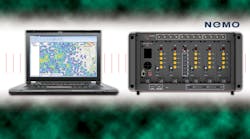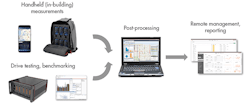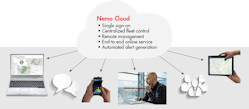Download this article in PDF format.
From the beginning stages of LTE network deployment to the impending roll-out of 5G, we’ve observed a rather significant evolution in wireless network testing. Such testing has transformed from being data-collection and post-processing centric to being an automated solution that performs end-to-end (e2e) processes. In other words, data collection, remote management, and post processing are all contained in a single process flow (Fig. 1). An increase in urgency, complexity, capital expenditure (CAPEX)/operating expenditure (OPEX), and competition are a few of the drivers behind this evolution.
For example, distributed-antenna-system (DAS) installations and deployments typically require special permissions and limited time to access venues, making it critical to ensure that the turnaround time for system verification is quick and without glitches. On the macro-cell segment with pre-post launch optimization and site verifications, an engineer was traditionally required to monitor the drive test gear with another “coordinator,” controlling when and what types of test measurements needed to be made.
1. Measurements, post-processing, and remote managing and reporting all merge into one automated flow.
Minimizing Errors and Saving OPEX with Automation
Typically, tasks revolve around coordinators sending the different files to the drive test engineers; ensuring version compatibility; communicating start/stop times pertinent to maintenance windows; checking in real-time over phone or text on the progress; and managing measurement data. Typically, at this point, the coordinator transitions to interface with a “post-processing” team. This team provides information concerning measurement data availability for post-processing and tracking progress to ensure the report is received by pertinent personnel.
Overall, significant human intervention is needed that is not only primarily OPEX-heavy, but also introduces the possibility of user errors along the way. This could easily become a big problem when project deliveries are extremely time-critical, which is normally the case.
Take These Four Steps to Achieve e2e Measurement Success
To successfully utilize an automated RF measurement solution, four basic issues must be resolved to result in quality of end-user experience (QoE) and offer possibilities for direct OPEX savings:
- Automation
- Integrity
- Real-time analytics
- Integration
Automation: Remove and restrict human intervention in all possible areas of the process
The basis is built around a centralized, web-based service to seamlessly enable remote control and management of measurement fleets. Measurement and analytics products are integrated. A single user can control nationwide measurement campaigns, reducing and eliminating the need for dedicated drive test engineers, coordinators, and manual post-processing.
Integrity: Identify potential failures as and when they happen
In a complex system that involves hardware and software, failures are certain to happen and should be expected. The key is to be able to identify these problems when they happen and issue alerts to quickly fix them. This requires a system that provides automated processes to address such failures. It should have advanced, customizable alerting mechanisms that allow for failures to be addressed before they affect the project.
Real-time analytics: Access network measurement data, make changes, and validate results in real-time
Smooth management is enabled by advanced dashboards for monitoring and real-time reporting. This way, a user can, in real-time, visualize the performance of the network, make changes, and validate them. Customized alerts simplify this process by identifying scenarios automatically.
For example, a user can configure custom alerts to identify areas with good reference signal received power (RSRP) but poor signal-to-noise ratio (SNR), and troubleshoot with real-time parameter changes and validation. Add to it the ability of an enterprise-level analytics system to pipe in core network data, correlate with drive test data, and provide customizable dashboards that have correlated data from both RAN and Core networks.
Integration: Consolidated view of processed information from multiple sources
It's typical to run into situations where RAN optimization is gated by core network issues that don't show up in RAN measurement data. At the same time, the root-cause detection in these cases can be a cumbersome process. Seamless integration of any type of core network data with RAN measurement data, along with customizable analytics, is enabled by analytics solutions.
Customer Case 1: Network Vendor with Managed Service Contract
Issue: Customer collects data from numerous drive test teams in the country and the data is downloaded for further post-processing. Once downloaded, the report generation takes days, with the possibility for corrupted data and failures in measurements. The current process is error-prone, as manual work brings the possibility of mistakes in the process and requires rework to be done.
Solution: Implementation of a cloud-based solution for remote management of drive-test measurements with fully automated report generation.
Benefit: Less errors in drive test measurements, leading to cost savings due to less re-drives. An improved quality of network is made possible thanks to more exact measures that enable exact troubleshooting. Reporting times have gone from days to hours, giving troubleshooting and optimization teams a more real-time picture of LTE network status, again improving network quality. The time reduction enables direct OPEX savings.
Customer Case 2: Operator with Need for Continuous Real-Time Benchmarking
Issue: Customer faces churn and needs to understand in more detail where network issues reside compared to the competition. Customer must swiftly troubleshoot and improve network quality.
Solution: Implementation of a cloud-based solution for remote management of autonomous unattended measurement solutions located in vehicles across the region, combined with automated reporting.
Benefit: Remote management of autonomous measurement probes, combined with automated reporting, enables the operator to obtain an overarching, real-time view of the network in comparison to the competition. Instant troubleshooting in challenging areas can be initiated and network improvement projects better targeted, ultimately focusing on improved network quality, increased customer satisfaction, and reduced churn. The condensed dashboard view of the network can easily be distributed at various levels of management and operative personnel throughout the company.
2. Nemo Cloud represents the core of automated RF measurements.
Summary
The constant cost pressure and evolving measurement needs have changed the nature of RF measurements. The focus today is an automated, single-process flow that performs e2e processes from data collection, to remote management, to post processing. The nature of such full-scale solutions is complex and requires integration between various measurement and analytics products. Instead of starting integration efforts from scratch, it is more effective to search for a single vendor solution, hence ensuring smoother setup and faster time to benefits.
The error-proneness of the old approach shouldn’t be underestimated. A variety of problems can crop up when companies perform drive testing and optimization: Errors in file naming, connecting to projects, selecting files manually, and sending files to incorrect folders.
Keysight’s Nemo Cloud, combined with its Nemo-branded RF measurement and analytics products, provide a solid base for automated e2e measurements that include drive testing, benchmarking, in-building measurements, and minimizing errors (Fig. 2). The end results are process (time and quality) improvements and OPEX savings.



